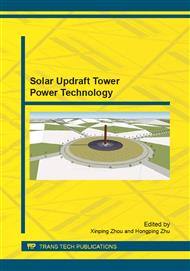p.3
p.9
p.15
p.25
p.35
p.41
p.47
p.57
A Compressible Transient Model of the Solar Chimney and Heat Collector
Abstract:
The compressible transient model of solar chimney power plant system was proposed. It was added to the pressure equation and the ideal gas state equation basis on the heat balance equation for the solar collector model. The air flow station can be easily calculated with the improved model. The results of dynamic changes of the total pressure difference calculated in the model were in good agreement with the given actual measured values in references. The solar chimney model was considered the influence of fluid pressure on the density. The influence of the structural chimney on the chimney efficiency was analyzed with the established model. It was shown that the chimney efficiency changes significantly with the chimney height and its diameter. The chimney efficiency was decreased with a convergent chimney shape while increased with the divergent one. When the tilt angle of chimney reached a peak and then further increased, the chimney efficiency was the constant. These results will provide the important reference to improving the system efficiency.
Info:
Periodical:
Pages:
15-21
Citation:
Online since:
January 2013
Authors:
Keywords:
Price:
Сopyright:
© 2013 Trans Tech Publications Ltd. All Rights Reserved
Share:
Citation:



